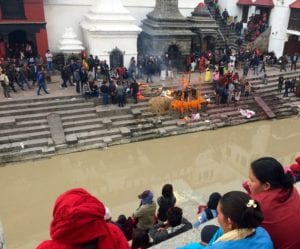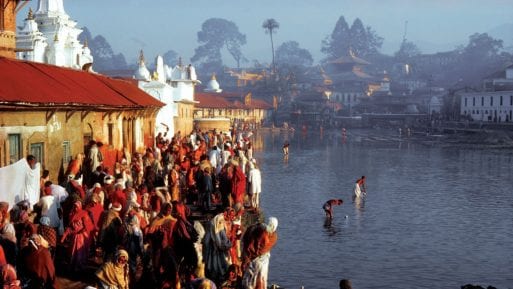Pashupatinath temple in Kathmandu, Nepal is one of the region’s most significant Hindu pilgrimage destinations. Located on the banks of the sacred Bagmati river, the sprawling temple complex includes hundreds of Shiva “lingams,” or symbols representing Lord Shiva, and overflows with devotees during the annual festival of Maha Shivaratri. It is also home to several funeral ghats, where Kathmandu valley’s Hindu population has flocked for centuries to perform cremation rites similar to those held at the burning ghats in Varanasi, India.
 Numerous funerals take place daily at Pashupatinath – typically just hours after a person’s death, when Hindu families come together to send loved ones into the afterlife. Hindus believe in reincarnation. After you die, you come back to life in another form, hopefully as a human, if your karma determines that to be your fortune, or potentially into a lower birth, such as that of an animal. Many believe that those cremated at Pashupatinath are guaranteed a human rebirth. Meanwhile, it is said that those cremated at Varanasi achieve nirvana and are no longer required to submit to the ongoing cycles of birth and death.
Numerous funerals take place daily at Pashupatinath – typically just hours after a person’s death, when Hindu families come together to send loved ones into the afterlife. Hindus believe in reincarnation. After you die, you come back to life in another form, hopefully as a human, if your karma determines that to be your fortune, or potentially into a lower birth, such as that of an animal. Many believe that those cremated at Pashupatinath are guaranteed a human rebirth. Meanwhile, it is said that those cremated at Varanasi achieve nirvana and are no longer required to submit to the ongoing cycles of birth and death.
A Communal Space for Mourning
Tradition mandates that Hindus engage in a 13-day ritual mourning period to ease the departed soul into the spirit realm. Alongside Pashupatinath, an ashram-like building known as Kriyaputri Bhawan provides mourners with the opportunity to perform these rituals nearby. Funded by a Nepali businessman living abroad, the building has some 50 rooms that accommodate thousands of mourners each month.
Hindu mourning rituals require practitioners to adhere to numerous restrictions –everything from abstaining from human touch or stimulating foods, to sleeping with their heads pointing north. A priest named Lila Prasad Acharya, who has spent many years leading rites at Kriyaputri Bhawan, told Hinduism Today that mourners garb themselves in white cloth to represent purity, and sit on wool blankets and rice straw mattresses to symbolize incorruptibility and adherence to the simplicity of nature. They often shave their hair to keep it from contaminating gifts, such as rice balls, which they offer daily as dictated by tradition. On the last day, mourners perform final rituals that include invoking the names of their ancestors and grasping the tail of a cow, which is believed to assist the departed spirit on its journey.
Because some people find it difficult to devote 13 days to mourning, the Kathmandu Post recently identified a trend of hiring surrogate mourners. These “mourners for hire” will stand in at Kriyaputri Bhawan and perform the necessary rituals on behalf of grieving Nepali family members.

 Hindu Cremations at Nepal’s Pashupatinath Temple
Hindu Cremations at Nepal’s Pashupatinath Temple



 John Mulaney’s “Funeral Planning” on Netflix: No Real Plan
John Mulaney’s “Funeral Planning” on Netflix: No Real Plan

 Composting Bodies Is Now Legal in a Dozen States
Composting Bodies Is Now Legal in a Dozen States














